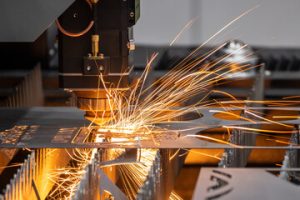Metal Fabrication Boise Idaho is a huge business in the states. Some companies work locally, while others are huge and make parts for companies all over the country.

These companies use advanced machinery to cut and shape metal. They also use computer-controlled machines to follow detailed patterns.
Companies specialize in one-of-a-kind, custom projects. They have a wide range of skills and can meet any customer’s needs.
Metal fabrication involves cutting, shaping and joining raw metals into a finished product. It’s a complex process that includes many different steps, from designing to assembly. The first step is the design phase, where engineers create a blueprint for a particular project that a metal fabrication company will later use during production. This stage is crucial because it determines the quality of the final product and how much the job will cost.
When choosing a metal fabrication company, it’s important to consider their experience and capabilities. Look for a company with an extensive portfolio and a wide range of products to choose from. For example, if you need a toolbox for your utility truck, a metal fabrication company should offer multiple options in terms of size and style. It’s also helpful to look for customer reviews and testimonials to gauge the quality of their work.
Another concern for metal fabrication companies is the labor shortage, which makes it difficult to hire new employees. The shortage is caused by several factors, including a perception that manufacturing jobs are dirty and low-tech, and the fact that many high schools have cut their vocational programs. In order to tackle the problem, many metal fabricators have implemented various strategies to attract and retain employees. These include offering flexible hours, providing training opportunities, and creating a positive workplace culture.
The next step in the metal fabrication process is cutting, where the fabricator cuts the raw material into chunks with the correct dimensions and shape. This can be done by laser cutting, waterjet sawing, shearing, or flame cutting. Often, the fabricator will maintain a tight tolerance in areas that are essential to the finished product and use a wider tolerance in areas that aren’t as critical.
Finally, the fabrication process can be completed by welding, forming, punching, or deep drawing. Forging is the most common method of forming raw metal, and it involves placing a raw material into a casting die mold. This process cools the molten metal, which then turns into a solid piece of the desired shape. Deep drawing is a technique used with ductile metals, such as aluminum, brass, and copper. It involves applying downward pressure to the sheet metal, which deforms it into a cup-like shape. This technique is commonly used to fabricate cans, cups, pots and pans, fuel tanks, and automotive bodies.
Cutting
A metal fabrication company can make many types of metal structures, including doors and gates. They can even make parts for cars and trucks. They can also work with different materials, such as aluminum and stainless steel. These companies can save you money by doing all the work in one place. You won’t have to pay for shipping fees, and you won’t have to worry about your product being damaged in transit.
The first step in the metal fabrication process is cutting the sheet metal. Fabricators can use a variety of tools to cut the metal, from manual snips to power saw blades. They may also use a laser cutter to create precise cuts. The type of tool used depends on the thickness and hardness of the material. For example, aviation snips are useful for thinner metals like copper or aluminum. For thicker metals, fabricators can use a mechanical saw.
After the cutting is done, fabricators must remove any sharp edges or burrs. This is a common finishing process, and it’s essential for improving safety and quality. Fabricators can do this manually with a set of aviation snips, or with specialized machinery. Some fabricators may also use a deburring machine to smooth out the surface of the metal.
Another important step in metal fabrication is drilling holes into the metal. The metal will then be bent or shaped to form its final shape. This can be done in a variety of ways, including shearing, punching, and milling.
Despite the many advantages of metal fabrication, the industry is facing a number of challenges. One of the biggest is a skilled labor shortage. As experienced fabricators retire, there aren’t enough people to replace them. This problem is exacerbated by the fact that many high schools have reduced or eliminated vocational programs.
Some manufacturers are working to address this issue by focusing on niche markets and using innovative technologies. They’re also trying to reduce waste and use less water in their processes. Moreover, they’re trying to find better ways to train and supervise new employees. In addition, some are investing in new equipment that uses less energy and produces fewer harmful chemicals.
Forming
The shaping and forming stage involves altering the shape of the metal. This may include cutting, shearing, bending, punching, or notching. Punching creates multiple overlapping notches or slits in the metal, which allows fabricators to achieve more complex shapes than with a single cut. This process is also known as nibbling. Notching cuts the material with a punch of varying size, including oblong or rectangular, which minimizes waste compared to a round punch. When fabricators want to remove more material from a piece, they use milling. This process is akin to machining, except it uses an oblong tool to remove material from the surface rather than from within the material.
Unlike shearing and machining, forming doesn’t deform the metal beyond its yield strength. This makes it a cost-effective and time-efficient process. It’s especially useful for creating long, straight parts with a fixed cross-section.
One of the challenges faced by the US metal fabrication industry is a shortage of skilled workers. As experienced fabricators retire, there aren’t enough young people entering the field to replace them. This shortage affects everything from welding to operating complex machinery. Another challenge is price fluctuations. When raw materials spike, it puts pressure on metal fabricators to increase their prices and hurts their margins. To combat this issue, many fabricators are focusing on reducing waste and improving efficiency to offset rising costs.
Some metal fabrication companies are going green, and this is good for the environment as well as the bottom line. They recycle scrap metal and use energy efficient machines to reduce their environmental footprint. Some even use solar panels on their roofs to save on electricity costs.
Other companies are working hard to stay competitive in the face of stiff competition from overseas. This includes focusing on their strengths, such as short turnaround times and close customer collaboration. They’re also investing in advanced technology to improve quality and efficiency. In addition, they’re developing new products to stay ahead of the curve and attract new customers. In the end, these measures can help metal fabrication companies compete with foreign competitors and keep their customers satisfied.
Finishing
The finished metal products you use in your home or workplace probably incorporate some kind of surface finishing. From galvanizing mild steel to polishing stainless steel, a wide range of finishes exist to keep the product’s design intact and improve its functionality. Choosing the right finish involves a nuanced approach to ensure the product can withstand environmental factors such as moisture and chemicals, while also maintaining its aesthetic integrity.
The future of the industry also includes automation, which allows machines to follow patterns and work more quickly than a human can, increasing production rates. However, it’s important to note that these advanced technologies are often accompanied by highly skilled workers who can handle more complex tasks that robots cannot do. For example, a machine might be able to do welding jobs that would take a skilled welder hours to complete, but it will still require an individual to program and operate the machine.
A big trend in the industry is to go green, with companies finding ways to reduce waste and save energy. One way is by recycling scrap pieces, which can then be melted down and reformed into new parts. Additionally, many companies are using cleaner energy sources like wind power or solar panels to reduce their carbon footprint.
Many companies are moving away from mass production and toward custom and on-demand projects. This means they’re creating unique, one-of-a-kind designs for their customers, rather than producing the same metal products over and over again. This is a good thing for the industry, as it allows metal fabricators to work on exciting projects that might not otherwise get done.
One of these innovative metal fabrication companies is Major Tool & Machine, which works with a number of different industries, including construction and agriculture. The company’s diverse skillset and long history make them a leading player in the industry. Another unique player is Lou-Rich, which is a family-owned company that specializes in a variety of metal fabrication services. The company is well-known for its ability to tackle large, intricate projects that other metal fabricators can’t.
